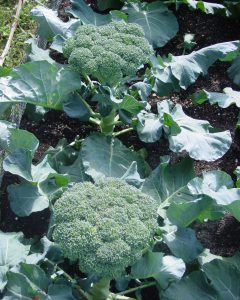
If you like broccoli as I do, you should keep in mind that it is a very easy-to-grow vegetable that needs to go into your garden at this time of year. I have already started my seeds for the coming season and am preparing the soil for planting. Classified as a “cool season crop”, broccoli does best during our fall and winter season. Full of nutrition, just one-half cup of this Mediterranean vegetable has more than half the vitamin C we need every day. Popular since the Roman Empire, let’s look how easy broccoli is to grow!
While the history of broccoli goes back thousands of years, and Thomas Jefferson actually grew broccoli in his garden, it really was not a popular vegetable until relatively recently in the United States. We commonly grow “sprouting broccoli” in the United States. The familiar branching cluster of sprouts with side sprouts is really a large edible, flower head. Harvest can occur in as early as sixty days for some varieties: up to one-hundred days for others. Start your broccoli patch with a full sun area and work in organic matter such as compost into the soil – I incorporate plenty of compost prior to planting each year. Prepare the soil pre-plant with a commercial granular fertilizer suitable for vegetables as per label instructions. Four- to five-week-old transplants work better than direct seeding and should be placed eighteen to twenty-four inches apart in rows thirty-six to forty-inches apart. As the plants grow, consider applying a side dressing of granular fertilizer, again as per label instructions. To avoid pests such as cutworms which may chew down a tender young transplant, put a four-inch cardboard collar around each newly planted plant to act as a barrier. Certain other leaf-feeding caterpillars may also show up which can be managed with hand-picking, or least-toxic insecticides such as Bt or Spinosad applied as per label directions. Rabbits can also be a problem which may require a chicken wire fencing barrier.
There are many broccoli varieties to choose from. ‘Waltham 29’, ‘Green Mountain’, ‘Spartan Early’, ‘Atlantic’, ‘Green Sprouting’, ‘Green Comet’, ‘Italian Green Sprouting’, ‘DeCicco’, ‘Green Duke’ and ‘Packman’ are very suitable for Florida gardens. Check local garden centers for availability. You may have to look on-line to obtain some varieties. Check the seed pack or label to see how long it will take from transplant to harvest – successive plantings can provide an extended crop for months.
When should you harvest your broccoli? Make sure to pick it when the head is tight and compact. Don’t wait too long as yellow flowers will begin to open at some point decreasing the quality of the broccoli. Include a good five inches of stalk with the head. As an added bonus, side shoots will develop offering smaller, but steady harvests for some time. Store unwashed in a plastic bag in the crisper of your refrigerator. Rinse well before eating or cooking.
Include broccoli as part of your vegetable garden or as an edible ornamental. Broccoli has a long history – a tasty history that you should not miss! For more information on all types of vegetables that you can grow in your yard, or to ask a question, you can also call the Master Gardener Volunteer Helpdesk on Mondays, Wednesdays, and Fridays from 1 to 4 pm at 764-4340 for gardening help and insight into their role as an Extension volunteer. Ralph E. Mitchell is the Director/Horticulture Agent for UF/IFAS Extension – Charlotte County. He can be reached at 941-764-4344 or ralph.mitchell@charlottecountyfl.gov, Connect with us on social media. Like us on Facebook @CharlotteCountyExtension and follow us on Instagram @ifascharco.
Resources:
UF/IFAS Gardening Solutions (2021) Broccoli. The University of Florida Extension Service, IFAS.
Stephens, J. M. (2018) Broccoli—Brassica oleracea. The University of Florida Extension Service, IFAS.
Brown, S. P., Treadwell, D., Stephens, J. M., & Webb, S. (2021) FLORIDA VEGETABLE GARDENING GUIDE. The University of Florida Extension Service, IFAS.
Source: UF/IFAS Pest Alert
Note: All images and contents are the property of UF/IFAS.



